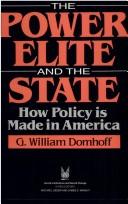Check nearby libraries
Buy this book

"This volume presents a network of social power, indicating that theories inspired by C. Wright Mills are far more accurate views about power in America than those of Mills's opponents. Dr. Domhoff shows how and why coalitions within the power elite have involved themselves in such policy issues as the Social Security Act (1935) and the Employment Act (1946), and how the National Labor Relations Act (1935) could pass against the opposition of every major corporation. The book descri bes how experts worked closely with the power elite in shaping the plansfor a post-World War II world economic order, in good part realized during the past 30 years. Arguments are advanced that the fat cats who support the Democrats cannot be understood in terms of narrow self-interest, and that moderate conservatives dominated policy-making under Reagan."--Provided by publisher
Check nearby libraries
Buy this book

Previews available in: English
Subjects
Politics and government, Elite (Social sciences), Power (Social sciences), Macht, Elite (Social sciences) -- United States, Politische Elite, Politische Willensbildung, Overheidsbeleid, Elites, Pouvoir (Sciences sociales), Élite (Sciences sociales), Politisches System, Politique et gouvernement, United States -- Politics and government -- 20th century, Elite, Regierung, United states, politics and government, 20th century, Power - social sciences, U.s. politics & government - 20th century, 20th century american history - politics & government - general & miscellaneousPlaces
United States, États-UnisTimes
20th century, 20e siècleShowing 4 featured editions. View all 4 editions?
| Edition | Availability |
|---|---|
| 1 |
zzzz
Libraries near you:
WorldCat
|
| 2 |
zzzz
Libraries near you:
WorldCat
|
|
3
Power Elite and the State: How Policy Is Made in America
1990, De Gruyter, Inc.
in English
3110127342 9783110127348
|
zzzz
Libraries near you:
WorldCat
|
|
4
The power elite and the state: how policy is made in America
1990, A. de Gruyter
in English
0202303721 9780202303727
|
aaaa
Libraries near you:
WorldCat
|
Book Details
Table of Contents
Edition Notes
Includes bibliographical references (p. 287-308) and index.
Classifications
The Physical Object
ID Numbers
Community Reviews (0)
Feedback?| July 27, 2024 | Edited by MARC Bot | import existing book |
| December 19, 2023 | Edited by ImportBot | import existing book |
| August 11, 2023 | Edited by | Merge works |
| August 14, 2020 | Edited by ImportBot | import existing book |
| December 10, 2009 | Created by WorkBot | add works page |









